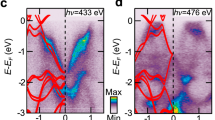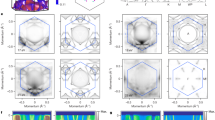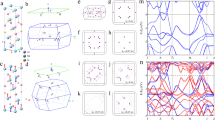Abstract
In quantum field theory, Lorentz invariance leads to three types of fermion—Dirac, Weyl and Majorana. Although the existence of Weyl and Majorana fermions as elementary particles in high-energy physics is debated, all three types of fermion have been proposed to exist as low-energy, long-wavelength quasiparticle excitations in condensed-matter systems1,2,3,4,5,6,7,8,9,10,11,12. The existence of Dirac and Weyl fermions in condensed-matter systems has been confirmed experimentally13,14,15,16,17,18, and that of Majorana fermions is supported by various experiments19,20. However, in condensed-matter systems, fermions in crystals are constrained by the symmetries of the 230 crystal space groups rather than by Lorentz invariance, giving rise to the possibility of finding other types of fermionic excitation that have no counterparts in high-energy physics21,22,23,24,25,26,27,28,29. Here we use angle-resolved photoemission spectroscopy to demonstrate the existence of a triply degenerate point in the electronic structure of crystalline molybdenum phosphide. Quasiparticle excitations near a triply degenerate point are three-component fermions, beyond the conventional Dirac–Weyl–Majorana classification, which attributes Dirac and Weyl fermions to four- and two-fold degenerate points, respectively. We also observe pairs of Weyl points in the bulk electronic structure of the crystal that coexist with the three-component fermions. This material thus represents a platform for studying the interplay between different types of fermions. Our experimental discovery opens up a way of exploring the new physics of unconventional fermions in condensed-matter systems.
This is a preview of subscription content, access via your institution
Access options
Access Nature and 54 other Nature Portfolio journals
Get Nature+, our best-value online-access subscription
$29.99 / 30 days
cancel any time
Subscribe to this journal
Receive 51 print issues and online access
$199.00 per year
only $3.90 per issue
Buy this article
- Purchase on Springer Link
- Instant access to full article PDF
Prices may be subject to local taxes which are calculated during checkout




Similar content being viewed by others
References
Castro Neto, A. H. et al. The electronic properties of graphene. Rev. Mod. Phys. 81, 109–162 (2009)
Fu, L. & Kane, C. L. Superconducting proximity effect and Majorana fermions at the surface of a topological insulator. Phys. Rev. Lett. 100, 096407 (2008)
Lutchyn, R. M., Sau, J. D. & Das Sarma, S. Majorana fermions and a topological phase transition in semiconductor-superconductor heterostructures. Phys. Rev. Lett. 105, 077001 (2010)
Oreg, Y., Refael, G. & Von Oppen, F. Helical liquids and Majorana bound states in quantum wires. Phys. Rev. Lett. 105, 177002 (2010)
Wang, Z. et al. Dirac semimetal and topological phase transitions in A3Bi (A = Na, K, Rb). Phys. Rev. B 85, 195320 (2012)
Young, S. M. et al. Dirac semimetal in three dimensions. Phys. Rev. Lett. 108, 140405 (2012)
Wang, Z., Weng, H., Wu, Q., Dai, X. & Fang, Z. Three-dimensional Dirac semimetal and quantum transport in Cd3As2 . Phys. Rev. B 88, 125427 (2013)
Wan, X., Turner, A. M., Vishwanath, A. & Savrasov, S. Y. Topological semimetal and Fermi-arc surface states in the electronic structure of pyrochlore iridates. Phys. Rev. B 83, 205101 (2011)
Xu, G., Weng, H., Wang, Z., Dai, X. & Fang, Z. Chern semimetal and the quantized anomalous Hall effect in HgCr2Se4 . Phys. Rev. Lett. 107, 186806 (2011)
Weng, H., Fang, C., Fang, Z., Bernevig, B. A. & Dai, X. Weyl semimetal phase in noncentrosymmetric transition-metal monophosphides. Phys. Rev. X 5, 011029 (2015)
Huang, S. M. et al. A Weyl Fermion semimetal with surface Fermi arcs in the transition metal monopnictide TaAs class. Nat. Commun. 6, 7373 (2015)
Soluyanov, A. A. et al. Type-II Weyl semimetals. Nature 527, 495–498 (2015)
Liu, Z. K. et al. A stable three-dimensional topological Dirac semimetal Cd3As2 . Nat. Mater. 13, 677–681 (2014)
Liu, Z. K. et al. Discovery of a three-dimensional topological Dirac semimetal. Na3Bi. Science 343, 864–867 (2014)
Lv, B. Q. et al. Experimental discovery of Weyl semimetal TaAs. Phys. Rev. X 5, 031013 (2015)
Xu, S.-Y. et al. Discovery of a Weyl fermion semimetal and topological Fermi arcs. Science 349, 613–617 (2015)
Lv, B. Q. et al. Observation of Weyl nodes in TaAs. Nat. Phys. 11, 724–727 (2015)
Yang, L. X. et al. Weyl semimetal phase in the non-centrosymmetric compound TaAs. Nat. Phys. 11, 728–732 (2015)
Mourik, V. et al. Signatures of Majorana fermions in hybrid superconductor-semiconductor nanowire devices. Science 336, 1003–1007 (2012)
Nadj-Perge, S. et al. Observation of Majorana fermions in ferromagnetic atomic chains on a superconductor. Science 346, 602–607 (2014)
Heikkilä, T. T. & Volovik, G. E. Nexus and Dirac lines in topological materials. New J. Phys. 17, 093019 (2015)
Wieder, B. J., Kim, Y., Rappe, A. M. & Kane, C. L. Double Dirac semimetals in three dimensions. Phys. Rev. Lett. 116, 186402 (2016)
Bradlyn, B . et al. Beyond Dirac and Weyl fermions: unconventional quasiparticles in conventional crystals. Science 353, aaf5037 (2016)
Winkler, G. W., Wu, Q., Troyer, M., Krogstrup, P. & Soluyanov, A. A. Topological phases in InAs1−xSbx: from novel topological semimetal to Majorana wire. Phys. Rev. Lett. 117, 076403 (2016)
Hyart, T. & Heikkilä, T. T. Momentum-space structure of surface states in a topological semimetal with a nexus point of Dirac lines. Phys. Rev. B 93, 235147 (2016)
Weng, H., Fang, C., Fang, Z. & Dai, X. Topological semimetals with triply degenerate nodal points in θ-phase tantalum nitride. Phys. Rev. B 93, 241202 (2016)
Zhu, Z., Winkler, G. W., Wu, Q. S., Li, J. & Soluyanov, A. A. Triple point topological metals. Phys. Rev. X 6, 031003 (2016)
Weng, H., Fang, C., Fang, Z. & Dai, X. Co-existence of Weyl fermion and massless triply degenerate nodal points. Phys. Rev. B 94, 165201 (2016)
Chang, G. et al. New fermions on the line in topological symmorphic metals. Preprint at https://arXiv.org/abs/1605.06831 (2016)
Strocov, V. N. et al. Three-dimensional electron realm in VSe2 by soft X-ray photoelectron spectroscopy: origin of charge-density waves. Phys. Rev. Lett. 109, 086401 (2012)
Strocov, V. N. et al. Soft-X-ray ARPES facility at the ADRESS beamline of the SLS: concepts, technical realisation and scientific applications. J. Synchrotron Radiat. 21, 32–44 (2014)
Kresse, G. & Furthmüller, J. Efficient iterative schemes for ab initio total-energy calculations using a plane-wave basis set. Phys. Rev. B 54, 11169–11186 (1996)
Perdew, J. P., Burke, K. & Ernzerhof, M. Generalized gradient approximation made simple. Phys. Rev. Lett. 77, 3865–3868 (1996)
Marzari, N. & Vanderbilt, D. Maximally localized generalized Wannier functions for composite energy bands. Phys. Rev. B 56, 12847–12865 (1997)
Acknowledgements
We thank B.-B. Fu, N. Xu and A. Chikina for assistance with the ARPES experiments. We thank Y. Shao and Y.-L. Wang for examining the topography of the (100) cleavage surface using scanning tunnelling microscopy, although the results are not shown. This work was supported by the National Natural Science Foundation of China (11622435, 11474330, 11422428, 11674369, 11474340, 11674371 and 11234014), the Ministry of Science and Technology of China (2016YFA0401000, 2016YFA0300600, 2015CB921300, 2013CB921700, 2016YFA0302400 and 2016YFA0300300) and the Chinese Academy of Sciences (XDB07000000). Y.-B.H. acknowledges support by the CAS Pioneer ‘Hundred Talents Program’ (type C).
Author information
Authors and Affiliations
Contributions
H.D. and T.Q. conceived the experiments; B.Q.L., X.G. and T.Q. performed the ARPES measurements with assistance from J.-Z.M., L.-Y.K., Y.-B.H. and V.N.S.; Q.-N.X. and H.-M.W. performed the ab initio calculations; B.Q.L., T.Q. and H.D. analysed the experimental data; B.Q.L., Q.-N.X. and T.Q. made the figures; T.Q., C.F., H.D., B.Q.L. and P.R. wrote the manuscript; and Z.-L.F. and Y.-G.S. synthesized the single crystals.
Corresponding authors
Ethics declarations
Competing interests
The authors declare no competing financial interests.
Additional information
Reviewer Information Nature thanks P. Hosur, A. Soluyanov and the other anonymous reviewer(s) for their contribution to the peer review of this work.
Publisher's note: Springer Nature remains neutral with regard to jurisdictional claims in published maps and institutional affiliations.
Rights and permissions
About this article
Cite this article
Lv, B., Feng, ZL., Xu, QN. et al. Observation of three-component fermions in the topological semimetal molybdenum phosphide. Nature 546, 627–631 (2017). https://doi.org/10.1038/nature22390
Received:
Accepted:
Published:
Issue Date:
DOI: https://doi.org/10.1038/nature22390
This article is cited by
-
Ultrafast magnetization enhancement via the dynamic spin-filter effect of type-II Weyl nodes in a kagome ferromagnet
Nature Communications (2024)
-
Experimental observation of multiple topological nodal structure in LaSb2
Science China Physics, Mechanics & Astronomy (2024)
-
Realization of practical eightfold fermions and fourfold van Hove singularity in TaCo2Te2
npj Quantum Materials (2023)
-
Anisotropic transport in a possible quasi-one-dimensional topological candidate: TaNi2Te3
Tungsten (2023)
-
High-throughput first-principle prediction of collinear magnetic topological materials
npj Computational Materials (2022)
Comments
By submitting a comment you agree to abide by our Terms and Community Guidelines. If you find something abusive or that does not comply with our terms or guidelines please flag it as inappropriate.



